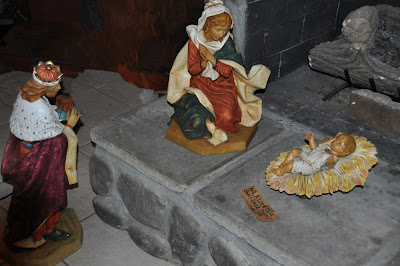Epiphany (the word meaning “showing forth” or “manifestation”) is one of the oldest Christian Feasts in the Church Calendar.
Most people associate this feast with the coming of the magi or Wise Men to bring gifts to the Christ Child in Bethlehem.
But there are other manifestations of God’s Presence that are also celebrated on this day. In the Eastern Church, the Baptism of Christ by John the Baptist, and another celebration is that of the miracle of Jesus changing water into wine, the Wedding at Cana. Because of these customs, in many churches water is blessed today.
On the last day of Christmas, we begin our Epiphany preparations at St. Simeon Skete.
In the back of the Skete’s barn, Seraphim has made space for a workshop.
It is his hope to establish a woodworking shop in order to maintain and tend to the work around the property as well as construct icon stands, etc.
In the barn, Seraphim begins making the Epiphany Cross. As he works he stresses that it is “vitally important that in making the Cross that you fashion the vertical beam first before the horizontal.
If you don’t have the vertical beam right, no matter how hard you work at the horizontal beam – it will never work.” he further explained “This is the same with the spiritual life: If you don’t have the vertical beam (represents your relationship with God) right, your horizontal (represents your relationship with man) will not work, it will not be right.”
Last evening, for us it was time to take the Christmas Tree down (before sunrise the day of Epiphany).
Today began as usual – walking over to the Chapel in the darkness of the wee hours of the morning.
The moon is beginning to set and lights the path.
 |
| 6 Jan 2012, Moon at 93% full |
Upon reaching the Chapel I meet Seraphim and enter into the ongoing stream of prayer.
Seraphim’s day begins earlier; he has been in the chapel now for hours.
After Lauds (Morning Prayer) we begin the Liturgy.
As is the custom at St. Simeon Skete on Epiphany, during the Offertory, the water is blessed and will be used as Holy Water for the coming weeks and months.
The font at the entrance to the Skete is filled with the Holy Water.
The Epiphany Cross is placed in the offering basin along with our rosaries. (At the skete we offer our beads that hold our prayers at every Mass)
The Cross is then blessed at the Altar.
Later a special procession is made to the nearest river (about a 15 minute hike through the woods for us at the skete) and the Cross is tossed into it, making all waters Baptismal Waters as the river carries the Cross from tributaries, to streams, to rivers, to oceans.
Following Mass as the sun rises, St. Simeon Skete keeps the tradition (Eastern Europe, Baltic Sea to Mediterranean) of blessing all the entrance doors on the property.
God’s blessing is then asked to be upon the building and all who dwell on within.
A piece of chalk is first blessed with holy water and the inscription is then written above the doorway.
20 + C + M + B + 12
The three initials stand for Christus Mansionem Benedicat – Latin for “May Christ bless this house”, although they also stand for names traditionally given to the Wise Men: Caspar, Melchior and Balthazar. They are enclosed by the numerals of the current year.
 |
| All doors of the Holy Trinity Kellia have been blessed for 2012 |
After Seraphim completed blessing all the doors of all the buildings on the Skete’s property, he began his journey,
carrying the Epiphany Cross through the woods to the river.
Saying the Jesus Prayer and the Rosary along the way
he stops to bless the entrances to the St. Arsenius’ hermitage hidden in the woods, and the newly found St. Elijah’s Cave.
Upon arrival at the river bank, Seraphim said the Service for Placing the Cross in the Water adapted from Office of Baptism.
After placing the Cross into the River, thus rendering all waters Baptismal, Seraphim recited the Luminous Mysteries.
| Taylorsville Lake, Taylorsville Kentucky |
Tonight, after the last Office of the day, we will remove the Nativity Scene from the Chapel although the Season of Epiphany will remain through four Sundays.













